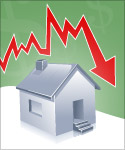
Survival of the fittest applies to economics as well as biology – in fact, some would argue the concept is better applied to the financial arena than any other area of study. Unfortunately, it’s a fact few Americans want to face head on… it goes against the steady diet of “American ingenuity” and the (false) belief that any child born in the good old USA can grow up to be anything they want. While there are exceptions to every rule, survival of the fittest is an economic trend currently undergoing the equivalent of an ice-age extinction as one era gives rise to an entirely new one. Research by consulting firm McKinsey found a few unsettling statistics that demonstrate the depth of the problem:
Over 70 percent of currently employed Americans work in jobs for which there is low or declining demand. This includes both blue collar and white collar. Competition for jobs that cannot be shipped overseas (healthcare for example) has created high competition which is driving down wages and promoting part-time, per diem, and other “job sharing” situations.
Mainstream stores are doing double-takes as consumers shift spending habits. Not only are brick and mortar stores under heavy competition from online retailers like Amazon but the bleak economy is finally taking a toll. Violating one of the core marketing principles ‘never undercut your own product', heavy weights ranging from Proctor & Gamble to Macy's are rolling out discount versions of their more expensive popular items. Cost of Tide got you down? Don’t worry, you can now buy Tide Basic…a discount version. Research shows 1/2 of Americans have already reduced spending and 1/3 plan to do so permanently with 18 percent of consumers switching from name brands to generics in the past two years alone.
So, how are Americans spending their money both today and into the near future?
- Nearly 34 percent of the average household income goes toward housing. Expect this trend to continue as people downsize into affordable housing options.
- Just over 19 percent goes toward entertainment and/or miscellaneous items…however, as a discretionary item this is subject to volatility.
- Roughly 17 percent goes toward transportation – a number of experts expect this to hold steady as people opt for more affordable options.
- Just under 13 percent goes toward food; a necessity to be sure but one that is subject to “replacement” purchases as people opt for hamburger instead of steak during tough times.
- Approximately 11 percent are on retirement and personal insurance.
- Nearly 6 percent are on healthcare.
Even a precursory look at where Americans spend their money tells the average investor where to spend theirs…housing, entertainment, transportation, food, financial products and healthcare. Those are the big six that run the American economy.
Now stop and consider which are available to the average “little guy” investor… Stocks and bonds for healthcare, insurance and finance have been decimated in recent years. The auto industry? Please! Now that it's been nationalized you can count on the same efficiency that brought you the driver license office to run the auto industry. Food is notoriously volatile and forget direct intervention unless you have an unusual level of gardening know how.
No, the answer remains the same today as it did 100 years ago…real estate! It's not easily outsourced, it's not subject to the market manipulations of stocks and bonds nor is it entirely dependent upon your ability to work yourself into an early grave. It simply requires a willingness to adapt to the new economic environment like all other species that learn to thrive or barely survive.



